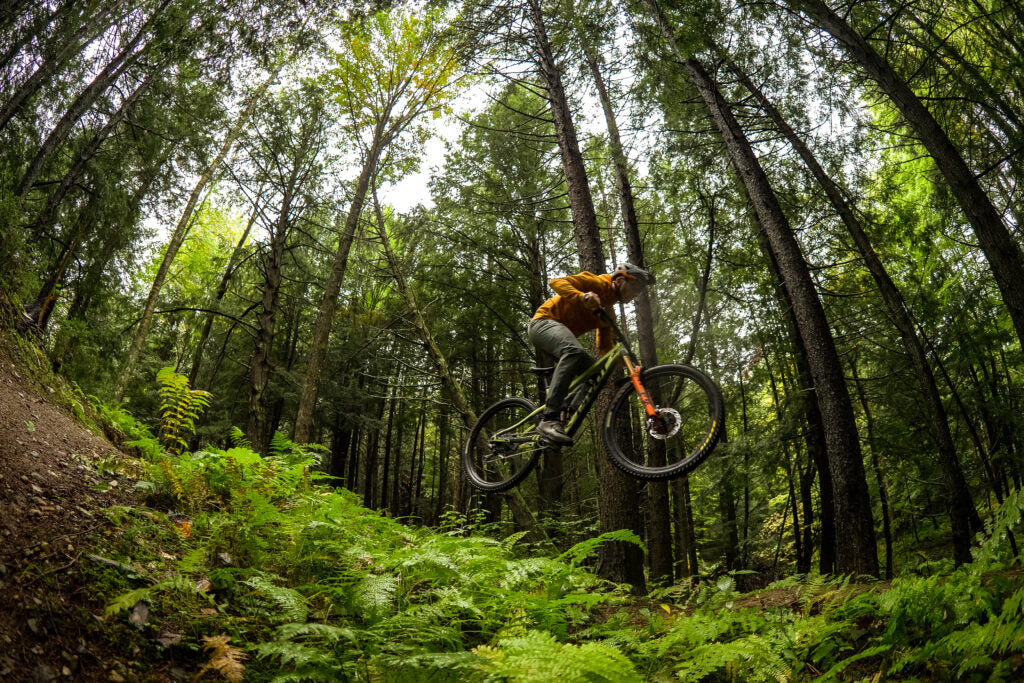In this installment of the Underexposed Series, Brice Shirbach travels to the Mad River Valley in Vermont where the trails are steep and advocacy runs deep.
The name “Vermont” comes from two French words, vert which means green, and mont which means mountain, so giving it the nickname “The Green Mountain State” is a bit on the nose. However, when I imagine America’s 14th state, I think the abundant lush green peaks and ridgelines that seem to be squeezed into a fairly tidy 9,600 square miles are top of mind.
By most mountainous standards, the Greens are fairly modest in scale, with only five summits punctuating its 250 mile long north-south journey, with the highest point topping out at over 4,000' above sea level. Several other summits throughout the Appalachian Mountains eclipse the heights reached in the Green Mountains, and of course many of the mountains throughout the American west sit on a mile-high plateau before they even begin to reach for the sky. But after nearly half of a billion years, you can forgive the Greens for having lost a bit off of the top. For everyone who has ever fallen in love with these mountains, it’s never been about scale. The same forces that have eroded peaks that at one point rivaled the heights reached by the current Himalayas, have also provided Vermont with incredibly deep and picturesque valleys, and these valleys are home to most of its famously rustic and quaint communities.



Route 100 is an unimaginably scenic two lane road that runs along a corridor, connecting several of those deep and picturesque valleys that rest at the feet of the Green Mountains. In fact, the five summits that breach 4,000 feet are a part of this spine running parallel to route 100, bookended to the north and south by Mount Mansfield and Killington respectively. Situated right in the middle of it all is the Mad River Valley. Named after the watershed of the Mad River, MRV is actually composed of several towns including Duxbury, Fayston, Moretown, Waitsfield, and Warren, though collectively they see themselves as more of a singular community with less of an emphasis on specific townships. Though it occupies the narrow valley between the densely forested ridges of the Green Mountains, the Mad River Valley is almost equidistance from the state capital of Montpelier, and the largest city Burlington, providing an attractive balance of urban proximity and access to high quality outdoor recreation. Home to an eclectic mix of trades including engineering firms, artists, innkeepers, and plenty more, many who call this place home originally did so due in large part to the ample opportunities available for skiers and snowboarders throughout the region.

While on the surface the Mad River Valley appears to be a mecca for winter pursuits, there has been a decades-long movement for locals to play in these mountains in a somewhat similar fashion, albeit on two wheels and dirt instead of one or two planks and snow, a contingent led by one of the very first nonprofits dedicated to trail access for mountain bikers in Vermont: the Mad River Riders.
“We’re a chapter of the Vermont Mountain Bike Association, or VMBA,” Bob Kogut tells me under a gazebo during one of several rain showers that met up with me in the Mad River Valley for virtually all five days of my visit. “We’re a chapter of the Vermont Mountain Bike Association, or VMBA. We (the Mad River Riders) have actually been around for longer than VMBA has. We got our start in the late 80’s and are one of the founding chapters of the statewide organization.”
Bob is an engineer by day, and has been the chapter president of the Mad River Riders for the last seven years. Following the same membership-based model of volunteerism and fundraising that many other 501(c)(3) mountain bike organizations follow as well, their purpose is to maintain and cultivate free public access to over 58 miles of multi-use trails throughout the MRV.



“They’re open year-round, and you can run, bike or ski on them for free.” he says. “There’s a sense of community here where we share this desire to get out in the woods together, and that’s just an awesome feeling. It’s great to have this awesome network of trails that we live next to, and we have plenty of people coming to explore our trails. It’s just such a cool place to hang out, so when you ask about what motivates me and others to volunteer our free time to do advocacy work that isn’t always super sexy, it’s because having trails like this is motivation enough.”
The trails throughout much of the Mad River Valley emphasize the mountains in mountain biking, with several of them built along the eastern facing aspect of the ridge that connects two of Vermont’s highest peaks: Mount Ellen and Mount Abraham. Additionally, the ski resort of Sugarbush operates a lift-served bike park during the summer, which really rounds out the riding experience here. While areas like Blueberry Lake offer riders a more mellow and beginner friendly opportunity, the trails high up are what truly set this place apart from so many other places.

I’ve had the opportunity to ride here during hot and dry summer days, as well as picture perfect days in late spring, but during my trip to film for this project, I was greeted with several consecutive days of (much needed) rain storms. While the showers left an abundance of slippery roots and rocks in its wake, the dirt remained heroic, offering reliable traction and zero slick spots over the course of my time in town. The impervious nature of the soil here, coupled with some of the best natural terrain found anywhere in the country makes for a veritable playground that very few places can touch.


The Mad River Valley is a lot of things packed into a narrow valley nestled against the spine of the Green Mountains. It’s a stunning and natural playground that offers world class pursuits for any number of outdoor enthusiasts. It’s also a quaint and picturesque community of artists and artisans. For those looking to put rubber to dirt, it’s more than an incredible collection of trails scattered throughout some of Vermont’s most ethereal forests: it’s also a shining example of advocacy and stewardship epitomized.





Comments